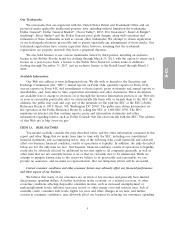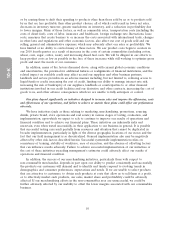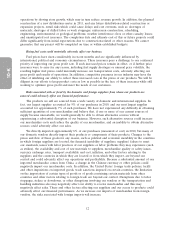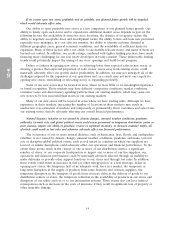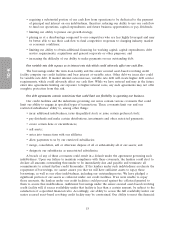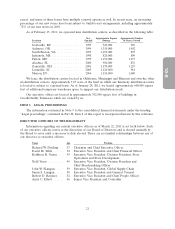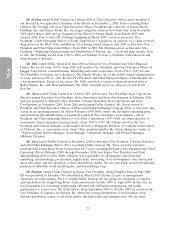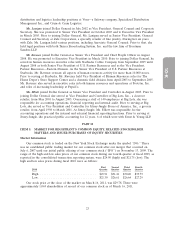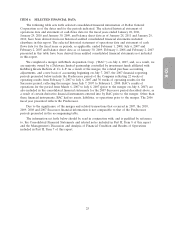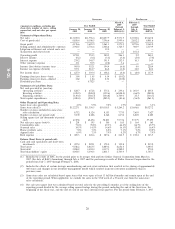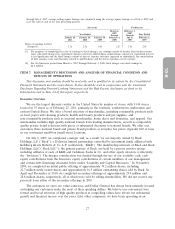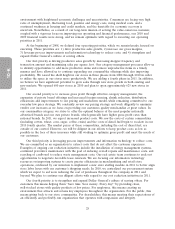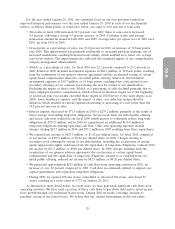Dollar General 2010 Annual Report Download - page 97
Download and view the complete annual report
Please find page 97 of the 2010 Dollar General annual report below. You can navigate through the pages in the report by either clicking on the pages listed below, or by using the keyword search tool below to find specific information within the annual report.
10-K
ratio can be affected by events beyond our control, and we cannot assure you that we will meet this
ratio, if applicable, and other covenants.
New accounting guidance or changes in the interpretation or application of existing accounting guidance
could adversely affect our financial performance.
The implementation of proposed new accounting standards may require extensive systems, internal
process and other changes that could increase our operating costs, and may also result in changes to
our financial statements. In particular, the implementation of expected future accounting standards
related to leases, as currently being contemplated by the convergence project between the Financial
Accounting Standards Board (‘‘FASB’’) and the International Accounting Standards Board (‘‘IASB’’), as
well as the possible adoption of international financial reporting standards by U.S. registrants, could
require us to make significant changes to our lease management, fixed asset, and other accounting
systems, and in all likelihood would result in changes to our financial statements.
U.S. generally accepted accounting principles and related accounting pronouncements,
implementation guidelines and interpretations with regard to a wide range of matters that are relevant
to our business involve many subjective assumptions, estimates and judgments by our management.
Changes in these rules or their interpretation or changes in underlying assumptions, estimates or
judgments by our management could significantly change our reported or expected financial
performance. The outcome of such changes could include litigation or regulatory actions which could
have an adverse effect on our financial condition and results of operations.
Kohlberg Kravis Roberts & Co. L.P. (‘‘KKR’’), certain affiliates of Goldman, Sachs & Co. (the ‘‘GS
Investors’’), and other equity co-investors (collectively, the ‘‘Investors’’) have significant influence over us,
including control over decisions that require the approval of shareholders, which could limit your ability to
influence the outcome of key transactions, including a change of control.
We are controlled by the Investors. The Investors have an indirect interest in approximately 71%
of our outstanding common stock through their investment in Buck Holdings, L.P. In addition, the
Investors have the ability to elect our entire Board of Directors. As a result, the Investors have control
over our decisions to enter into any corporate transaction and the ability to prevent any transaction
that requires shareholder approval regardless of whether others believe that the transaction is in our
best interests. As long as the Investors continue to have an indirect interest in a majority of our
outstanding common stock, they will have the ability to control the vote in any election of directors. In
addition, pursuant to a shareholders’ agreement that we entered into with Buck Holdings, L.P., KKR
and the GS Investors, KKR has a consent right over certain significant corporate actions and KKR and
the GS Investors have certain rights to appoint directors to our Board and its committees.
The Investors are also in the business of making investments in companies and may from time to
time acquire and hold interests in businesses that compete directly or indirectly with us. The Investors
may also pursue acquisition opportunities that are complementary to our business, and, as a result,
those acquisition opportunities may not be available to us. So long as the Investors, or other funds
controlled by or associated with the Investors, continue to indirectly own a significant amount of our
outstanding common stock, even if such amount is less than 50%, the Investors will continue to be able
to strongly influence or effectively control our decisions. The concentration of ownership may have the
effect of delaying, preventing or deterring a change of control of our company, could deprive
shareholders of an opportunity to receive a premium for their common stock as part of a sale of our
company and might ultimately affect the market price of our common stock.
19


